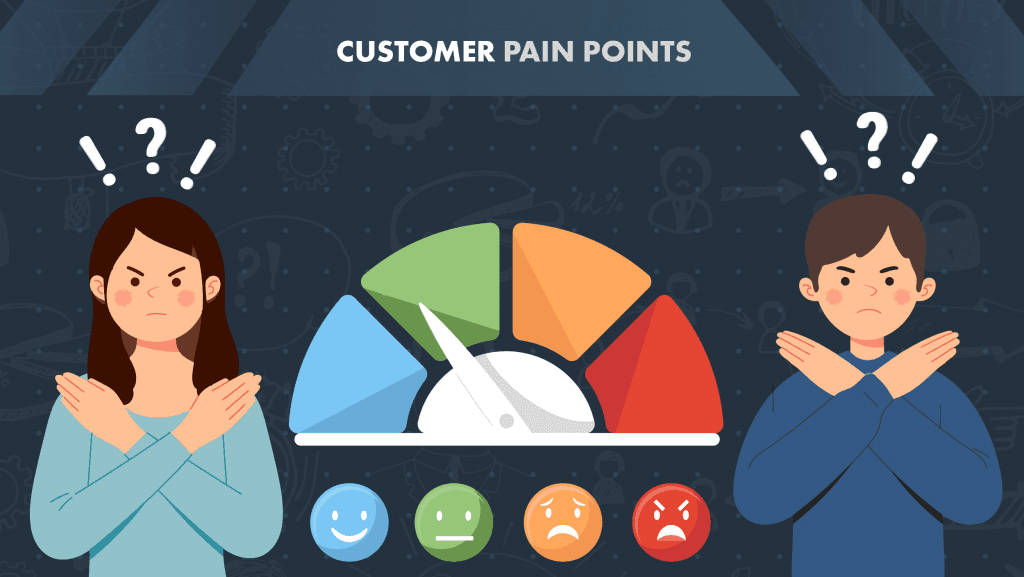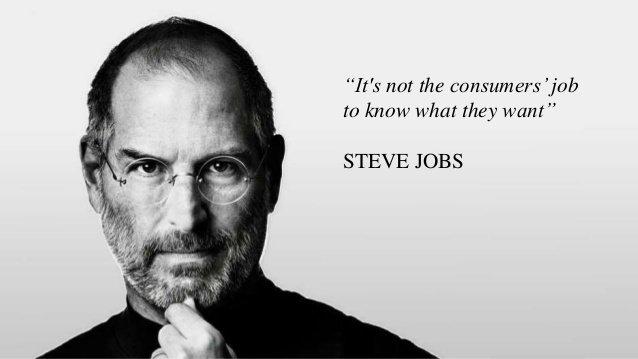
Customer pain points, everybody even tangentially related to sales talks about them. Heck it’s one of the corner stones you must uncover if you want to successfully automate your business! But what are they? How do you see one coming and how do you deal with it?
In this article – we’ll be looking into the mind of our customer, explore ways to understand it and nudge it into the right direction.
To be honest for many of you, this might sound like Sales and Marketing 101; However, it’s still a very debated topic, with many sides to consider, especially so in the ever-fast-changing world we live in. So, here’s our take on it.

What is a customer pain point or Sales 101
In order to sell anything, you must know your customer and what they are willing to buy; Be that a service or a product.
And to know the “what” in that statement we need to uncover the problems our prospects or existing clients are facing, be that in their day-to-day lives, using someone’s product or using particularly your product or service.
For existing clients it’s important to map out their full customer journey, and analyse it from top to bottom, to find all the possible issues your customer might be facing.

For the saying goes “The customer is always right” but equally so “It’s not the customers job to know what they want”.
When it comes to prospects, the story doesn’t change that much, except you don’t really have a clear structure of a customer’s journey, when, he’s not yet your customer. Duh.
At this point think of yourself as a consultant, not a salesperson, listen and ask questions! And it is imperative to ask the correct questions, try to put yourself into the shoes of your customer and face the same pains he’s facing, or pain points.
So, what is a customer pain point? Essentially it defines a specific problem encountered by the customer.
We’ve touched upon the topic previously, and back then we applied the distinction on to businesses. Today, we’re applying these as a sales/marketing representative onto our clients, lets break them apart into four wide-ranging categories of Customer Pain Points.

These are: Productivity pain; Financial pain; Process pain and Support pain; now it’s important to note that customer pain points are incredibly complex and these four are merely most common ones, but not the only ones; we’ve categorized them in such a manner for a better understanding:
Financial pain
This category involves the most known and possibly most effective approach to sales, and that is money.
Specifically, how much is the client willing to spend, or is spending on a product/service, and all possible issues on finance. Think of these as “Expensive membership fees”; “Extra tax/fees”; “No transparency” etc.
Productivity pain
Everything related to efficiency and streamlining the customer to his desired goal. This category of pain points encompasses customers who wish less redundant systems, faster resolution of the purchase and no effort on their part etc; Think – “Nobody likes standing in a line at a grocery store”.
This category has the titular productivity in mind for the customer as well. We all worry about us procrastinating, it’s an ever-present nagging feeling that we could be using our time better; That is a strong point to push.
Process pain
Under process pain points, we have a strong overlap with the previous category – customers want comfort and ease-of-use of a product/service. However, unlike the productivity pain points, we must introspect, do we have business-processes that slow the customer experience or create unnecessary friction? Is everything in place to make it easier on the customer? Simply put, is your company optimised to give the customer the best experience available on the market?
Support pain
And finally, we have the support pain points. These involve whether the customer is receiving enough or better yet “crucial” information – on your landing page, in your marketing efforts, on the label, during customer service calls etc.
Remember it’s extremely hard to earn a customer’s trust and amazingly easy to lose it, and by far the strongest tool in that aspect is your customer service!

So how do I identify my customers pain points?
Now that we know what we’re looking for, let’s move on to “how to do it”.
Whether you’re a big company or a starting-out enterprise, the first thing you want to do is market research. And the main questions you want to focus on in the first stages is the “who”; “what” and “why”. Remember that, we’ll come back to it.
There are multitude ways of approaching this. However, there are two main methods we’ll focus on today. “Quantitative Market Research” and “Qualitative Market Research”.
Quantitative Market Research – The needs of the many…
When and if you’re trying to encompass as big of a market as possible, there’s no other way than to go –

Quantitative Market Research is a method primarily reliant on using polls, surveys, and questionnaires on large target audiences in an organized fashion. We all love to receive those in our mail inboxes.
Advantages of such a technique
- Numerically based theories – as its name implies, quantitative market research provides you with large bite chunks of numbers on anything and everything. We all love a good pie chart, and this is exactly that, with use of right tools you get insights into large parts of the population, in rational understandable numbers. Little is left to guess work.
- Higher willingness of recipients – quantitative research largely compromises a list of close-ended questions, quick and simple, requiring less time and effort on the consumer to answer and thus higher response rates.
- ROI on brand awareness – with advances in technology and the digital era taking a survey is easy and fast, thus cost of investment into a market research can be off-set by costs in generating awareness of your brand.

However, here are some disadvantages:
- Shallow data – due to its nature, you have a vast ocean of information on “who” and “what” but because you’re lacking the “why”, its shallow as a puddle. This data usually has little on explaining itself.
- Sample size matters – creating a thorough analysis on a large audience is incredibly difficult and size matters, the bigger the sample, the better results, but also the costs. And precise targeted-market audiences are usually not indicative of the larger picture.
- Rigid structure – the best part of quantitative market research is also its worst quality. Because the questions and surveys are distributed on a large scale, and have limited flexibility, there’s no option to validate or explain the answers.
- Risk of trust – people if given a choice are usually sceptical to give out too much information due to security related or other reasons; With the same logic they can give out of scope or incorrect information completely invalidating their part in the survey, and thus hurting the overall precision of the Data.
Qualitative Market Research – Finding the “why”
Quality trumps quantity, in big enough numbers. Because today’s topic is customer pain points, we are more interested in the “why” rather than anything else.
So, we suggest going with Qualitative Market Research. And the reason for that is all customer pain points are incredibly complex, layered, and hyper individualized.
Imagine it like two customers can’t decide if its a duck or a rabbit? The underlying causes to it might be completely different, or even opposite.

You can and should group these under the previously discussed categories as long as you remember that they can still vary immensely within those groups.
Qualitative Market Research relies on detailed responses based on open ended questions and an opportunity to explain their answers in detail.
First thing you want to do is have a talk with your sales and customer service representatives. They are the ones on the frontline of your business and have access to most insight into what issues your customers experience. Just make sure you explain the difference between customer pain points and their own.
And listen, you should be doing that most, if your colleagues tell you about problems with their work arrangements, schedules or tools; this would fall under the process pain point, because at the end of the day the customer is the one who gets hurt and thus your entire business!
Listen out for feedback, it might be “I enjoyed your services, but it’s just too expensive and another company just dropped their prices” or “I didn’t know you put extra fees on X, I won’t be buying from you again!” these obviously fall under the financial pain points.
And the second thing…
The art of asking the right questions
“So, what should I be asking my prospects or clients?”

Now comes the hard part, and that is creating the right questions; An Art-Form in and of itself. Your primary goal should be digging down and uncovering the real issues, beyond the surface level.
Tell you the truth, this topic deserves its own article on how to do it. But if you keep to these simple rules, you will be fine!
- Focus on open-ended questions. Avoid giving the choice of binary answers (yes/no).
- Fight the urge to sell prematurely, listen first and uncover their problems.
- Don’t try to lead them to your product, earnestly ask and listen.
- Make sure to go into detail, supplement your questions with: How, Who, What, Where, When and importantly Why?
- Convey your intention to supply a solution to their problem.
“What is the main thing holding you back when you do x?”
“How do you usually solve a problem like x?”
“Where do you think the market is going?”
“How do you deal with deadlines when x happens?”
“What does your boss think?”
“What top 3 things annoy you the most during your workday/profession?”
That last one is among our favourites! We’ve discussed how you should step into the shoes of your client, well prior to making direct questions, spend some time trying to produce top 5 problems YOU think your customer experiences.
Then rank yourself how well you did, this will help you in the prioritization of customer pain points as well.
The internet is for… growth and learning!
Also, market research. If you want to find more information on your customers pain points, simply hit the open forum/gold mine that is the internet! There’s a plethora of open sources of information like Reddit, Quora or Digg, among others. Read what common people have to say about a product/service/daily problem, note it down and categorize it accordingly, and solve that problem!
How to solve customer pain points? Conclusion
Once you’ve done your research, and grouped and prioritized your customers pain points, this question becomes easier, but not by much, to answer.
Because customer pain points are so unique and individual its nigh impossible to supply a clear answer on exactly how to do it; create a plan, evaluate resources and decide if your company can realistically provide a solution to your customer.
But if lost remember the following mantra.
"Ask the right questions, earn their trust, and solve their problem!"
This should be the main principle on which your enterprise stands on. Also remember this core rule of sales – “People buy based on their emotion, not logic”.So, trust and human decency should be your top currency!
It’s important to note that “customer pain points” is something that needs to be evaluated on a continues basis. They can change and evolve with time as the market expectations shift.
Also, never forget that it’s unrealistic to solve every customer pain point, hence learn to know which ones to let go or ignore; customers can be illogical and unreasonable, because they are people, and some people…

Farewell
This article is partially related to an ongoing series into digital transformation. We’ve discussed how it all started and who were the first among the best; for the old saying goes:
“To pave the future, one must understand the past!”
Later, we moved on to outline the first steps you want to follow, and even discussed some of the heroic tools like Customer Relationship Management and Enterprise Resource Planning that save you from uncertainty and growth loss, leading to efficiency.
And before we close, I would love to hear what specific customer pain points you’ve found amusing or interesting with your business? Down in the comment section!
Stay classy business nerds!
Share this article on:
Sign up for our
newsletter.
Be up-to-date with our latest news, in-depth insights, and privileged content.

Technology
In this article, Alex shares his journey through the implementation of a Clean Desk and Clean Screen Policy during his company's ISO 27001 certification process. Initially resistant to the changes, Alex reflects on the impact of the policy on his workflow, physical security habits, and overall job experience. The transition, while initially perceived as a challenge, ultimately led to a cultural shift within the company, emphasizing the importance of information security and organizational efficiency.
21 Jan 2021

Programming Languages
Let’s take a deep dive in time and look at how computer science & programming languages began. Follow us as we go through the ages and look at the timeline, major personalities, and events that through their ingenuity paved the road to our current Technological and Digital Era.
03 Apr 2021